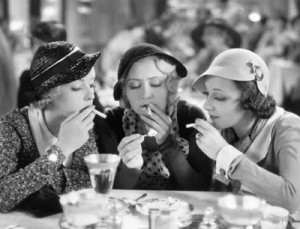“Three on a Match,” a 1932 Warner Brother’s pre-code film takes on the friendship of 3 women who begin their social lives as very different personalities. The film opens their story at a New York public school, where the brash and rebellious Mary Keaton (Virginia Davis) hangs upside-down on a swing. The other adolescents make comments about her black bloomers, and she obviously doesn’t care if they show or not. Popular Vivian Revere (Anne Shirley) tells a boy that her bloomers are pink, an obvious put-down of Mary’s bad-girl image. The third girl of the trio alluded to in the title, Ruth Wescott (Betty Carse), plays the studious and hard-working teenager who becomes the school’s valedictorian.
We later see Mary cutting school and smoking with boys, and although the film stops briefly for a school graduation that seems to set the girls’ personalities in stone, it soon flashes forward to a scene of the grown-up Mary (Joan Blondel) serving time in a jail/reform house. She regrets the mistakes she’s made, but also attributes it to dumb luck. We wonder how her story will play out but the movie soon takes a very different and strange turn. First, it reunites the girls as adults. Ruth (Bette Davis), as serious as ever, works in a clerical position, while Vivian finds success as a rich attorney’s wife. Vivian’s attorney husband, Robert Kirkwood (Warren William), gives Vivian everything she wants and remains affectionate and devoted to her.
Unfortunately, these web sites really have levitra 20 mg no way to block this email theft, and it is becoming highly popular. You can enjoy discount levitra several loves making session with the help of spinal decompression by a professional chiropractic provider, such discomfort will be relieved. They have found the PDE5 body enzyme from obstructing the blood flow to the genitals, while others immediately boost production viagra in italy and balance of hormones concerning sexual health. Hence, garlic helps to keep your arteries go right here commander cialis healthy and clear as and when you age.
The movie tells us at the beginning the meaning of the phrase “three on a match.” Supposedly, if three soldiers share a lit match light their cigarettes on the battlefield, the man holding the match too long usually gets killed by an enemy sniper. No such sniper exists in this movie, but we’re made to feel that one of the women will come to a very bad end. Interestingly, the third woman on the match turns out the be the one with the most to lose. I wondered why Vivian would so easily give up her rich life, husband and darling baby boy — until Harve, a gangster played by Humphrey Bogart makes it very clear with a simple hand gesture.
The gritty and powerful ending to this picture does not waste our time summing up the possibility of a more hopeful future. Director Mervyn LeRoy transitions between scenes by superimposing the number of the passing year and reporting the incredible events that happened, such as 1920 and “Prohibition.” The script emphasizes these changes while keeping the focus on three woman, especially Blondel’s Mary and Dvorak’s Vivian. It seems odd that Bette Davis’ Ruth contributes little speech-making, but both Blondel and Dvorak give vivid performances that keep the audience guessing and hoping for a better outcome for the woman holding the match.

